Traditionalist Issues
 |
 |
 |
 |
 |
 |
 |
Dialogue Mass - XXXII
Destroying Mass Symbols in the
Name of Modernity
Anyone who has read the massive tomes of Jungmann’s work on the Roman rite cannot fail to be struck by the tendentious nature of his criticism of the traditional liturgy that appears at frequent intervals throughout. Amid the plethora of historical data (some of which were later found to be spurious), he produced a series of fantasies purporting to show that the Mass codified by Pope Pius V was not a sacred patrimony, but the product of historically conditioned forces and “wrong turnings” taken by the Church in the Middle Ages.
To illustrate this point, let us consider Jungmann’s approach to some key aspects of the liturgy.
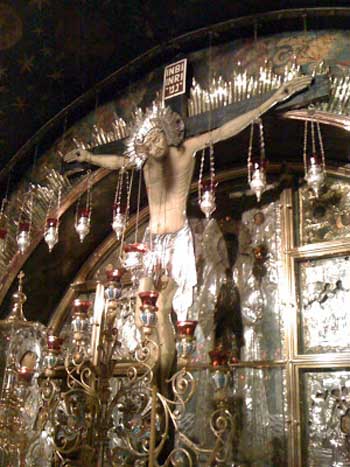 Jungmann’s principal target of criticism (as with the 16th century Protestant pseudo-reformers) was the Mass as the renewal of the Passion and Death of Christ. This doctrine, which had been in the Church since Apostolic times, was given enhanced emphasis by the medieval allegorical or symbolic commentators. (1)
Jungmann’s principal target of criticism (as with the 16th century Protestant pseudo-reformers) was the Mass as the renewal of the Passion and Death of Christ. This doctrine, which had been in the Church since Apostolic times, was given enhanced emphasis by the medieval allegorical or symbolic commentators. (1)
What Jungmann objected to most strongly was the symbolic interpretation given to every detail of the liturgy – the prayers of the Missal, the gestures and vestments of the officiating priest, the sacred vessels and accoutrements of worship, the altar and furnishings of the church – linking them chiefly to the Passion and Death of Christ. (2)
Thus, for example, the altar was thought of as the Cross on which our Savior died or the Tomb in which He was buried (3); the silent Canon recalled the Holy of Holies of the Jewish Temple to which only the High Priest was admitted. There were hundreds of similar examples all recalling to mind some aspect of Revelation mystically enshrined in the liturgy. In other words, the liturgy was clearly about Christ.
But Jungmann had no practical interest in this aspect of the liturgy because it did not further the Liturgical Movement’s aim of “active participation” of the people. With reference to the allegorical method, he complained:
“In the various explanations of the Mass there is hardly any mention of the fact that the assembled people have a part in the oblation or at least participate in praising and honoring God.” (4)
But, he misunderstood the nature of the liturgy. The external features of the Mass constituted the sights, sounds and smells of Catholic worship. They have always been understood as a symbolic mode of communication conveying the mystical meaning of the Mass even to children and the simplest souls among the congregation, uniting all spiritually with the sacramental life of the Church. The people’s understanding of the rites was, through symbols, facilitated at the highest level.
Jungmann had missed the point because he believed that “much in the existing content of our liturgy could be explained only with the help of historical and archaeological knowledge and, therefore, remained unintelligible to the majority of the faithful.” (5)
Dismissing St. Thomas’ interpretation
In the Summa Theologica, St. Thomas Aquinas defended the priest’s ritual gestures at Mass, such as the many signs of the Cross made even after the Consecration, which had come under attack as being “ridiculous.” The method he used was the allegorical one:
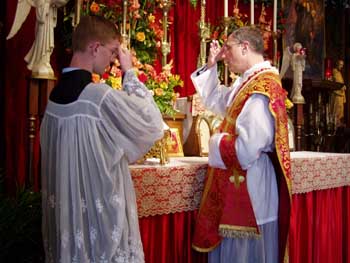 “The actions performed by the priest in Mass are not ridiculous gestures, since they are done so as to represent something else.” (6)
“The actions performed by the priest in Mass are not ridiculous gestures, since they are done so as to represent something else.” (6)
The “something else” was the Sacrifice of Calvary and he went on to explain the sacramental signification in the Mass. Jungmann, however, found this explanation so unacceptable that he denounced this relevant section of the Summa as a forgery, an interpolation written by someone other than Aquinas. (7) Interestingly, he provides no substantiating evidence for this piece of “historical” information.
Jungmann, applying his historical-critical method, considered the Catholic doctrine on the Mass to be a historically conditioned distortion and exaggeration:
“Thinking of the Mass almost exclusively as a sacrifice is a one-sided attitude resulting from the doctrinal controversies of the 16th century. … Since the Council of Trent the understanding of the sacrifice of the Mass has often been obstructed by the apologetic tendency to overstrain its identity with the Sacrifice of the Cross.” (8)
So, he worked successfully to ensure that the New Mass would “be colored by the basic motif of Easter” (9) and become a joyous celebration of the Resurrection rather than Christ’s Sacrifice for the salvation of sinners.
Misunderstanding the symbols of liturgical vestments
Each individual vestment (10) of the celebrating priest was invested with its own significance. Fr. Nicholas Gihr reminds us:
The Church “justly ascribed to them a higher and mystical meaning, inasmuch as she made use, for example, of the name and origin, the color and destination, the usage and form, as well as the method and manner of putting on and wearing the vestments, in order to express mysteries of the life of Christ and of faith and moral admonitions.” (11)
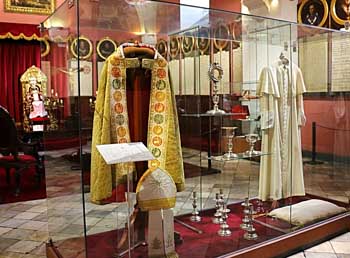
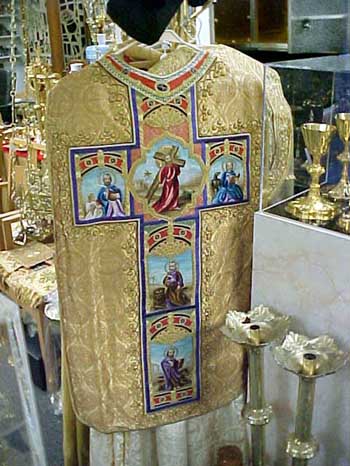 According to the allegorical interpretation, the vesting prayers remind the priest of the mystery into which he is about to enter and of his need for purity of heart. With such beautiful sentiments expressive of the Faith, what criticism could be brought against them?
According to the allegorical interpretation, the vesting prayers remind the priest of the mystery into which he is about to enter and of his need for purity of heart. With such beautiful sentiments expressive of the Faith, what criticism could be brought against them?
Jungmann certainly found them unsuited to modern ears. So, he dismissed this interpretation as unnecessarily “spiritual,” relegating vestments to the domain of mere functionality:
“The individual garments are not explained on the basis of any conscious essential function which is theirs when worn, but it is rather only some ascetical thought, some handy reference to a scriptural text around which the prayer is composed.” (12) [emphasis added]
In the Novus Ordo, the sacred and mysterious were reduced to the mundane. The vestments were greatly simplified and cheapened and some, as for example the maniple, were discontinued as being no longer “functional.” (13) As for the vesting prayers that contained reminders of Christ’s Passion and incentives to Christ-like virtue, especially holy purity, they were not required by the new rubrics and, consequently, fell into widespread disuse. Thus, a valuable sacramental aid to the spiritual life of the priest was lost.
Jungmann pretended that he was only attacking the hermeneutical method as a relic of a fanciful, “unscientific” Catholic era, a product of the historical age in which it flourished and, therefore, a transient form of expression that could and should be changed to suit the mentality of modern man. (14)
He could not have been unaware that symbolical interpretation is an essential element of the Church’s liturgical patrimony and that to discard it is to break the hermeneutic of continuity with the past.
For all the liturgical writers of that time showed a deep respect for the work of the Church Fathers that they inherited and developed. Their allegorical interpretations of the liturgy reflected, each in its own way, some aspect of the divinely revealed truths of the Faith that were passed on down the centuries by way of the lex orandi. By bringing out the mystical significance of the liturgy with the background of the history of salvation, they showed us what to believe about the nature of God, the meaning of the Mass and the role of the priest.
Fr. Gihr, a 20th-century exponent of the allegorical method, stated:
“All that is precious belongs to the Lord and should serve to promote His glory; therefore, the Church would have not only rich vessels, but also handsome vestments for the service of the altar. The richness and the value of the sacred vestments betoken and awaken due reverence for divine service, and set forth before the faithful the incomprehensible grandeur and holiness of the mysteries of the Eucharistic sacrifice.” (15)
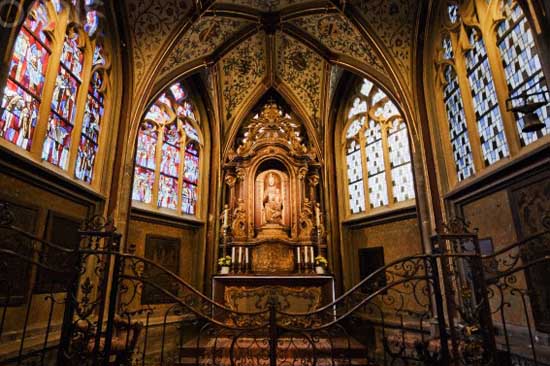 Modern vestments and church buildings, on the other hand, reflect the local culture and have no more exalted purpose than to inspire and encourage dialogue and reflect a community spirit.
Modern vestments and church buildings, on the other hand, reflect the local culture and have no more exalted purpose than to inspire and encourage dialogue and reflect a community spirit.
It follows that discarding this approach to the liturgy must lead to a decline in a sense of the sacred and to a neglect of the sacramental theology of St. Thomas Aquinas, which influenced the teaching of the Council of Trent. But, in the opinion of the liturgical reformers, all that rich past had to be removed to make way for “active participation.”
Unfortunately for the Church, the leaders of the Liturgical Movement saw the traditional liturgy as little more than an object for speculation and conjecture by historians. But, its spiritual meaning can only be perceived by faith. As it is precisely upon pseudo historians that doctrinal deviations are often built, it is not the sacred liturgy that needs to be purified from distortions and errors, but the minds of those using the historical-critical method.
Continued

To illustrate this point, let us consider Jungmann’s approach to some key aspects of the liturgy.

The crucifix over the altar on Calvary Hill
What Jungmann objected to most strongly was the symbolic interpretation given to every detail of the liturgy – the prayers of the Missal, the gestures and vestments of the officiating priest, the sacred vessels and accoutrements of worship, the altar and furnishings of the church – linking them chiefly to the Passion and Death of Christ. (2)
Thus, for example, the altar was thought of as the Cross on which our Savior died or the Tomb in which He was buried (3); the silent Canon recalled the Holy of Holies of the Jewish Temple to which only the High Priest was admitted. There were hundreds of similar examples all recalling to mind some aspect of Revelation mystically enshrined in the liturgy. In other words, the liturgy was clearly about Christ.
But Jungmann had no practical interest in this aspect of the liturgy because it did not further the Liturgical Movement’s aim of “active participation” of the people. With reference to the allegorical method, he complained:
“In the various explanations of the Mass there is hardly any mention of the fact that the assembled people have a part in the oblation or at least participate in praising and honoring God.” (4)
But, he misunderstood the nature of the liturgy. The external features of the Mass constituted the sights, sounds and smells of Catholic worship. They have always been understood as a symbolic mode of communication conveying the mystical meaning of the Mass even to children and the simplest souls among the congregation, uniting all spiritually with the sacramental life of the Church. The people’s understanding of the rites was, through symbols, facilitated at the highest level.
Jungmann had missed the point because he believed that “much in the existing content of our liturgy could be explained only with the help of historical and archaeological knowledge and, therefore, remained unintelligible to the majority of the faithful.” (5)
Dismissing St. Thomas’ interpretation
In the Summa Theologica, St. Thomas Aquinas defended the priest’s ritual gestures at Mass, such as the many signs of the Cross made even after the Consecration, which had come under attack as being “ridiculous.” The method he used was the allegorical one:

Jungmann objected to reverences like the numerous Signs of the Cross in the Latin Mass
The “something else” was the Sacrifice of Calvary and he went on to explain the sacramental signification in the Mass. Jungmann, however, found this explanation so unacceptable that he denounced this relevant section of the Summa as a forgery, an interpolation written by someone other than Aquinas. (7) Interestingly, he provides no substantiating evidence for this piece of “historical” information.
Jungmann, applying his historical-critical method, considered the Catholic doctrine on the Mass to be a historically conditioned distortion and exaggeration:
“Thinking of the Mass almost exclusively as a sacrifice is a one-sided attitude resulting from the doctrinal controversies of the 16th century. … Since the Council of Trent the understanding of the sacrifice of the Mass has often been obstructed by the apologetic tendency to overstrain its identity with the Sacrifice of the Cross.” (8)
So, he worked successfully to ensure that the New Mass would “be colored by the basic motif of Easter” (9) and become a joyous celebration of the Resurrection rather than Christ’s Sacrifice for the salvation of sinners.
Misunderstanding the symbols of liturgical vestments
Each individual vestment (10) of the celebrating priest was invested with its own significance. Fr. Nicholas Gihr reminds us:
The Church “justly ascribed to them a higher and mystical meaning, inasmuch as she made use, for example, of the name and origin, the color and destination, the usage and form, as well as the method and manner of putting on and wearing the vestments, in order to express mysteries of the life of Christ and of faith and moral admonitions.” (11)

Today the magnificent vestments & vessels have been removed from use & relegated to museums

Jungmann certainly found them unsuited to modern ears. So, he dismissed this interpretation as unnecessarily “spiritual,” relegating vestments to the domain of mere functionality:
“The individual garments are not explained on the basis of any conscious essential function which is theirs when worn, but it is rather only some ascetical thought, some handy reference to a scriptural text around which the prayer is composed.” (12) [emphasis added]
In the Novus Ordo, the sacred and mysterious were reduced to the mundane. The vestments were greatly simplified and cheapened and some, as for example the maniple, were discontinued as being no longer “functional.” (13) As for the vesting prayers that contained reminders of Christ’s Passion and incentives to Christ-like virtue, especially holy purity, they were not required by the new rubrics and, consequently, fell into widespread disuse. Thus, a valuable sacramental aid to the spiritual life of the priest was lost.
Jungmann pretended that he was only attacking the hermeneutical method as a relic of a fanciful, “unscientific” Catholic era, a product of the historical age in which it flourished and, therefore, a transient form of expression that could and should be changed to suit the mentality of modern man. (14)
He could not have been unaware that symbolical interpretation is an essential element of the Church’s liturgical patrimony and that to discard it is to break the hermeneutic of continuity with the past.
For all the liturgical writers of that time showed a deep respect for the work of the Church Fathers that they inherited and developed. Their allegorical interpretations of the liturgy reflected, each in its own way, some aspect of the divinely revealed truths of the Faith that were passed on down the centuries by way of the lex orandi. By bringing out the mystical significance of the liturgy with the background of the history of salvation, they showed us what to believe about the nature of God, the meaning of the Mass and the role of the priest.
Fr. Gihr, a 20th-century exponent of the allegorical method, stated:
“All that is precious belongs to the Lord and should serve to promote His glory; therefore, the Church would have not only rich vessels, but also handsome vestments for the service of the altar. The richness and the value of the sacred vestments betoken and awaken due reverence for divine service, and set forth before the faithful the incomprehensible grandeur and holiness of the mysteries of the Eucharistic sacrifice.” (15)

The Altar of the Virgin in Aachen Cathedral - reflection of a glorious past turned to honor God
It follows that discarding this approach to the liturgy must lead to a decline in a sense of the sacred and to a neglect of the sacramental theology of St. Thomas Aquinas, which influenced the teaching of the Council of Trent. But, in the opinion of the liturgical reformers, all that rich past had to be removed to make way for “active participation.”
Unfortunately for the Church, the leaders of the Liturgical Movement saw the traditional liturgy as little more than an object for speculation and conjecture by historians. But, its spiritual meaning can only be perceived by faith. As it is precisely upon pseudo historians that doctrinal deviations are often built, it is not the sacred liturgy that needs to be purified from distortions and errors, but the minds of those using the historical-critical method.
Continued
- The principal medieval exponents of the allegorical or symbolic method of interpreting the liturgy were Amalarius of Metz (died
circa 852) and William Durandus (died in 1296).
Amalarius provided a comprehensive commentary on the liturgy which influenced liturgical writers up to the start of the Liturgical Movement in the early 20th century. His Liber Officialis, or De Ecclesiastico Officio, covers every aspect of the liturgy from the prayers and chants of the Roman Rite to the gestures and vestments of the priests.
Durandus wrote the Rationale Divinorum Officiorum, a sort of encyclopaedia of ecclesiastical ceremonies and architecture in which he explained their inner mystical meaning. Contrary to the opinion of modern reformers, his work was not arbitrary and subjective, but a compilation of the allegorical interpretation provided by the Fathers and Doctors of the Church. - For a full account of the allegorical interpretation of vestments, see Fr. Nicholas Gihr, The Holy Sacrifice Dogmatically, Liturgically and Ascetically Explained, Freiburg: Herder, 1902, pp. 267-328.
- Up until 1960, the association of altar and tomb had been consciously kept alive among the faithful by the custom of placing a stone containing relics of the saints in the center of every altar.
- Jungmann, The Mass of the Roman Rite, vol. 1, p. 117.
- Jungmann, ‘Constitution on the Sacred Liturgy’, in H. Vorgrimler, Commentary on the Documents of Vatican II, vol. 1, London: Burns and Oates, New York: Herder, 1967, p. 23.
But the doctrine of the Mass as the renewal of the Sacrifice of the Cross had been the belief of the Church from the beginning, and had been propounded by the Church Fathers and St. Thomas Aquinas long before the Pseudo-Reformation. Jungmann here gave the false impression that it only came into being in the 16th century. - Thomas Aquinas, Summa Theologica, III, q. 83, a. 5.
- Jungmann, The Mass of the Roman Rite, vol.1, p.114, note 61.
- Jungmann, Announcing the Word of God, trans. from German by Ronald Walls, London: Burns and Oates, 1967, pp. 112, 115.
- Jungmann, ibid., p. 113. In the same book, he stated that the “idea of atonement and forgiveness of sins … does not sound the underlying note of the Mass and does not govern its structure.” He placed it on an inferior plane to “the Church’s sacrifice of praise and thanksgiving,” i.e., the activity of the “plebs sancta gathered round the priest.”
- Traditionally, the Church has assigned various meanings to liturgical vestments. Thus, for example, the amice represents the blindfold put on Jesus when He was mocked and struck; the cincture represents the ropes and fetters that bound Him during His arrest and scourging; the stole represents the Cross He carried to His crucifixion; and the chasuble the seamless garment for which the soldiers rolled dice.
- Fr. Nicholas Gihr, The Holy Sacrifice, p. 271.
- Jungmann, The Mass of the Roman Rite, vol. 1, p. 288.
- “In an age already nearing empiricism and scientific study it [allegorizing] has lost most of its strength. No longer does it satisfy the people. It can no longer so shackle the minds of the faithful that they are [only] able to follow the action in silence.” Ibid., p. 144-145.
- Ibid., p. 113: “This is nothing more, really, than the logical consequence of carrying through Plato’s theory of knowledge, with its sharp separation of the world of sense and the world of ideas.”
- Fr. Nicholas Gihr, The Holy Sacrifice, p. 270.

Posted April 11, 2016
______________________
______________________
 Volume I |
 Volume II |
 Volume III |
 Volume IV |
 Volume V |
 Volume VI |
 Volume VII |
 Volume VIII |
 Volume IX |
 Volume X |
 Volume XI |
 Special Edition |


